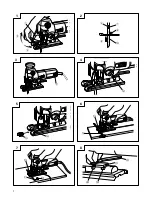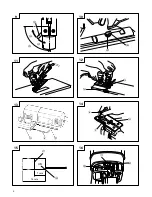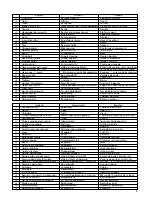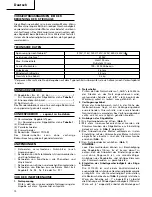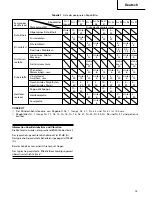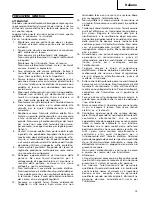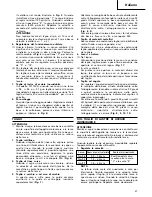
English
6
CUTTING
CAUTIONS
䡬
While sawing, the base must be firmly in contact
with the material surface, and the blade must be
held at a right angle.
If the base becomes separated from the material,
it could cause the blade to break.
1. Rectilinear cutting
When cutting on a straight line, first draw a marking
gauge line and advance the saw along that line.
Using the auxiliary straight guide (sole separately)
will make it possible to cut accurately on a straight
line. Attach the guide by passing it through the
attachment hole on the base and tightening the M5
knob bolt. (
Fig. 6
)
2. Sawing curved lines
When sawing a small circular arc, reduce the feeding
speed of the machine. If the machine is fed too fast,
it could cause the blade to break.
3. Cutting a circle or a circular arc
In this case it will be helpful to use the auxiliary
circular guide and guide center (sold separately)
(
Fig. 7
).
Loosen the base handle located directly below the
housing by rotating it approximately 90 degrees.
Then move the base fully forward, rotate the base
handle approximately 90 degrees counterclockwise,
return the base to directly below the housing and
tighten (
Figs. 8, 9
).
Pass the circular guide through the attachment hole
on the base and tighten the M5 knob bolt.
4. Cutting metallic materials
Always use an appropriate cutting agent (spindle
oil, soapy water, etc.) When a liquid cutting agent
is not available, apply grease to the back surface
of the material to be cut.
5. Pocket cutting
(1) In lumber
Aligning the blade direction with the grain of the
wood, cut step by step until a window hole is cut
in the center of the lumber. (
Fig. 11
)
(2) In other materials
When cutting a window hole in materials other than
lumber, initially bore a hole with a drill or similar
tool from which to start cutting.
6. Angular cutting
To adjust the slant angle, loosen the base handle
located directly below the housing by rotating it
approximately 90 degrees and then move the groove
in the semi-circular part to the position indicated
by the mark on the gear cover.
Next, align the scale (from 0 degrees to 45 degrees
in 15-degree increments) of the semi-circular part
of the base with the [
] mark on the gear cover,
rotate the base handle approximately 90 degrees
counterclockwise, return to directly below the
housing and tighten (
Figs. 8, 9, 10, 12
).
CONCERNING CUTTING OF STAINLESS
STEEL PLATES
CAUTION
While sawing, the base must be firmly in contact with the
workpiece surface, and the blade must be held at a right
angle. If the base becomes separated from the material,
it could cause the blade to break.
When cutting stainless steel plates, adjust the unit as
described below:
1. Adjust the speed……
NOTE
Dial scale reading is for reference only. The higher
the speed is, the quicker the material is cut. But
the service life of the blade will be reduced in this
case. When the speed is too low, cutting will take
longer, although the service life will be prolonged.
Make adjustments as desired.
2. Set the orbital position to “0” ………
NOTE
䡬
When cutting use cutting fluid (oil base cutting
fluid) to prolong the blade’s service life.
SELECTION OF BLADES
䡬
Accessory blades
To ensure maximum operating efficiency and results,
it is very important to select the appropriate blade
best suited to the type and thickness of the material
to be cut. Three types of blades are provided as
standard accessories. The blade number is engraved
in the vicinity of the mounting portion of each
blade. Select appropriate blades by referring to
Table 1
.
HOUSING THE SAW BLADES AND THE
HEXAGONAL BAR WRENCH
It is possible to house the auxiliary hexagonal bar wrench
and saw blades (2-3 blades) inside the base (see
Fig. 13
).
If saw blades get caught in the interior of the base, insert
the auxiliary wrench inside the groove on the back of the
base to remove the blades. (
Fig. 14
)
MAINTENANCE AND INSPECTION
1. Inspecting the blade
Continued use of a dull or damaged blade will
result in reduced cutting efficiency and may cause
overloading of the motor. Replace the blade with
a new one as soon as excessive abrasion is noted.
2. Inspecting the mounting screws:
Regularly inspect all mounting screws and ensure
that they are properly tightened. Should any of the
screws be loose, retighten them immediately. Failure
to do so could result in serious hazard.
3. Inspecting the carbon brushes (Fig. 15)
The motor employs carbon brushes which are
consumable parts. When they become worn to or
near the “wear limit”, it could result in motor trouble.
When an auto-stop carbon brush is equipped, the
motor will stop automatically.
At that time, replace both carbon brushes with new
ones which have the same carbon brush Numbers
Blade
Thickness of material
Dial Scale
No. 96
0.5 ~ 1.5 mm
No. 95
1.5 ~ 2.5 mm
No. 97
1.5 ~ 2.5 mm
Middle groove position
between scales “2”
and “3”
Содержание CJ 110VA
Страница 3: ...1 3 1 4 5 6 7 8 1 2 3 4 8 9 7 A C D L K J I 2 B E F E G H E ...
Страница 4: ...2 9 10 11 12 13 14 15 L M N O J P T S F E U 7mm 14mm 46 R Q D 6 6 5 16 D ...
Страница 36: ...34 ...
Страница 37: ...35 ...



